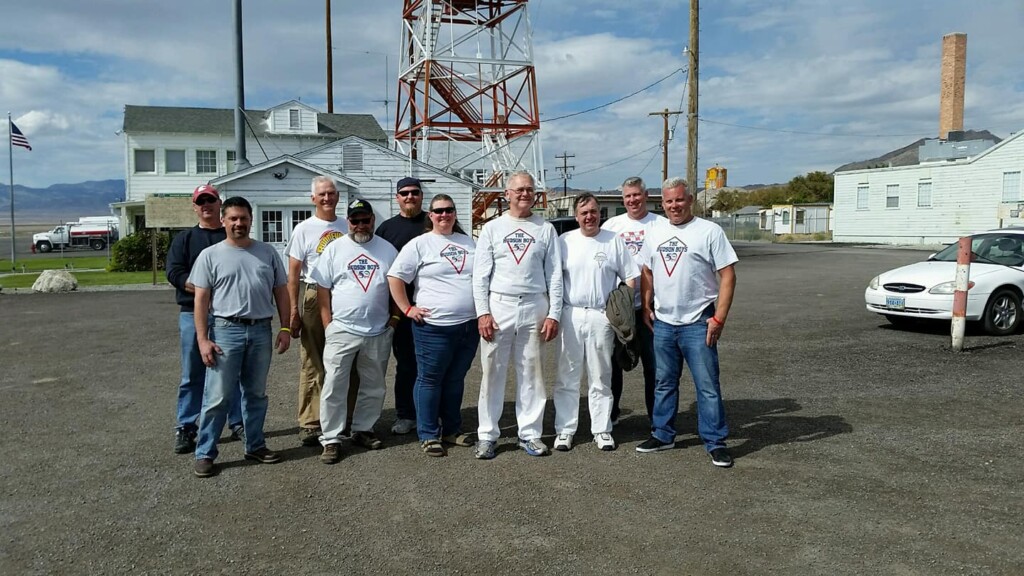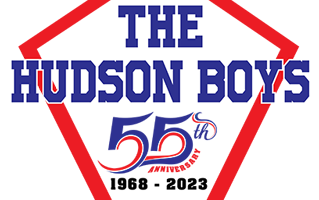FIFTY YEARS AGO
In 1968 a young man took one of his family cars, a 1942 Hudson coupe, to race at the Bonneville Salt Flats. He and his high school and life-long friend, Don Wilson, took a week to transform the car by adding tubing for a roll bar, adding a fire extinguisher system, swapped in a fresh engine, used Don’s ’56 Thunderbird tires and aluminum wheels speed, and drove to Wendover driving the car and towing a 16 foot travel-trailer.
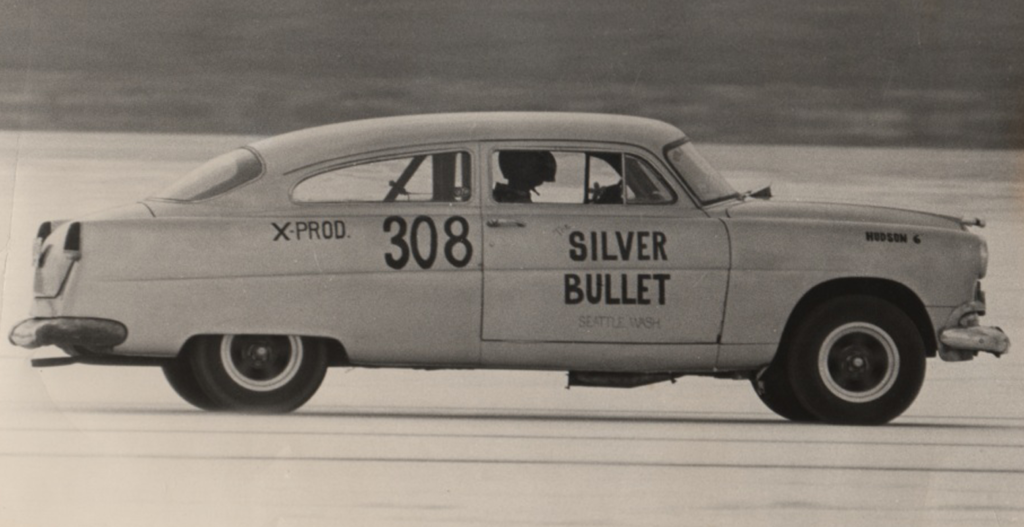
The car had been a “garage” find. The original owner has stored the car in his garage and went to war. It had a straight 8 in it with a broken rear end, 3 on the tree with overdrive, factory, clear vinyl seat covers, odometer at 25,000 miles, shiny body, and Rich purchased it for $50. Rich drove the car in college, used the car as his “get away” car when he was married in 1965, and drove it for 6 years and another 75,000 miles. He installed a ’53 Hudson Hornet engine with twin H power (from a junk yard – cost $50), installed a ’53 Ford Woody station wagon rear end (same odd width Spicer 44 with 4.11 gears that cost $50), and now had around $150 in the car.
In 1960’s only 10-20 records were set each year. All record setters and many participants got photos and mention in Hot Rod Magazine. There were tight rules with a continued emphasis on safety. It was a “time” when you could actually do something to be “best” in the field if you had the skills and energy to pull it off. Rich and Don read about the cars and stars in car magazines and thought “we could do this.” Maybe not as fancy, but it was a kind of racing where “amateurs” with little money could participate. Fire suits were cotton coveralls dipped at the track in a supplied barrel of a borax solution and air dried, making the finished texture like they were heavily starched. Don had always wanted to race at Bonneville and both were adventurous.
THE DRIVE DOWN
On the drive down, going over Snoqualmie Pass, they were passed by a Cadillac, which wouldn’t do. They then passed the Caddy using 2nd gear in overdrive, but the overdrive failed and they then drove the rest of the 22-hour trip more slowly in high gear. They learned that there weren’t many gas stations along the route of two-lane blacktop. Most shut down at night. The attendants in the full-service stations were mechanics and recognized the race cars. In those days, there weren’t any Mini Markets run by cashiers. They learned about trailering (trailer and tongue weight) when leaving Snoqualmie Pass and the car/trailer got sideways on the road. They moved the Honda 160 motorcycle forward to the front tongue of the trailer and proceeded with caution.
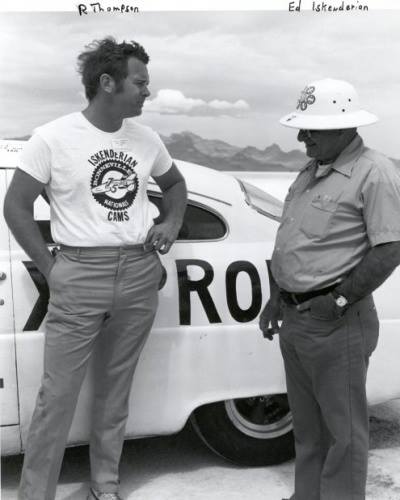
FIRST WEEK
They stayed in Wendover an entire week, hoping the weather would improve and the course would dry out. The salt was probably 20 inches deep in 1968. The course never dried out and the event was cancelled at the end of the week. All of the big names in racing were there and there were many opportunities for social interaction. Not that many cars were racing then, no internet yet, and many chances to visit, look, learn, and wait because “the salt might be OK later.”
They didn’t bring many tools or equipment, but as long as they were idled, they decided to replace the transmission, one of the few spare parts they brought along. They didn’t bring a jack or stands so they dug a hole in the gravel pit so they could easily get under the car. The new transmission was 1.5 inches longer and the drive shaft didn’t fit. So both men decided to jump on the small Honda 160, with Rich carrying the drive shaft over his shoulder, and go into the desert to Salt Lake City to get it fixed. Into their trip they were passed by a semi-truck and trailer and blown off the road into a ditch (another learning moment in the middle of the desert). They picked up parts, dusted themselves off, and decided then and there that they weren’t going to make it to Salt Lake City. There was a Kaiser Plant nearby and they probably had a machine shop. It was lunch time. When the crew there stopped laughing, they let them use a lathe to shorten the drive shaft but wouldn’t let them use the welder to put it back together (liability concerns). On the way back to town, timid about bow wakes from semis, they pulled over when they saw a tractor-trailer. Back in Wendover, they talked a gas station attendant into using his buzz box arc welder. They aligned the shaft on the cement floor and welded it back together again. Hoping the balance wasn’t too bad, they went back to the gravel pit, reinstalled parts, drove car, filled in hole, and waited for the salt to dry. They drove about 100 miles to a KOA near Salt Lake City just to get a shower. They took a highway back towards Wells to test the car at speeds up to 115 mph (speedometer) and decided “we were in tall cotton” since the class record was 95 mph. We were green, poor, and naïve.
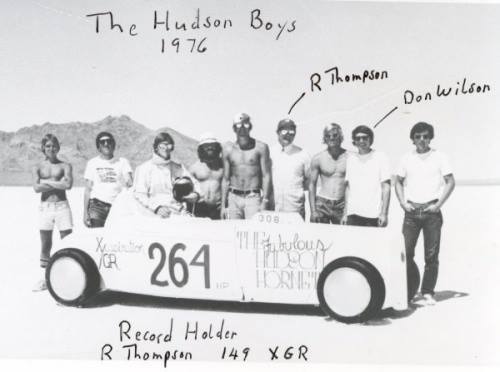
FIRST WEEK CANCELLED BUT TRIP HOME ALSO EXCITING
Driving back towards Seattle, they burned a hole in the muffler and it caused a red-hot spot on the floor board in the back seat. They had spilled a gallon jar of rear end grease in the back seat. It didn’t burn off but got VERY smoky in the car. They had to stop every 100 miles, pour water on the grease to cool it, and that helped reduce the smoke. With smoke pouring out of the windows and no hope of fixing it, traffic was light and they just kept going.
Later on, the trip home, driving west towards Portland, at night, along the Columbia River Gorge, the headlights and windshield wipers failed. Interstate 5 in Washington had just been newly paved and widened and it was very foggy from Olympia north. There wasn’t any stripping done yet and it was tough to stay on the road. Rich drove the entire way and they were dead tired. After healing a week at home, they decided “this was for us” and began planning for the next car. It was Don’s fantasy to set a record and it seemed like a good idea. Don is now a member of the 200 mph Club. He has set 20 records over 200 mph and one over 250 mph with a Hudson Hornet engine.
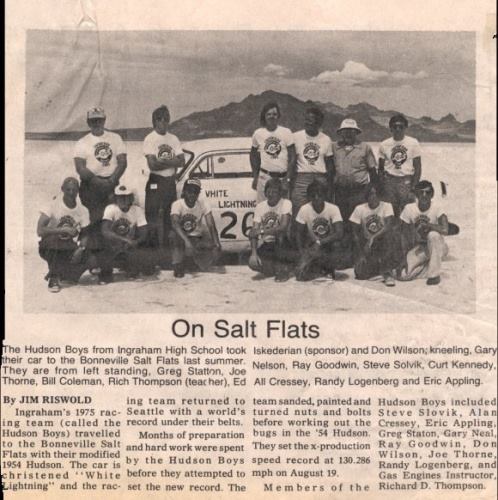
LATER ADVERTURES – MADDNESS CONTINUES – WE WERE HOOKED
For several years Rich returned to the Salt Flats with his Ingraham High School auto shop students for Speed Week. They were often referred to as “The Hudson Boys.” Through his trips and his 33 years in the classroom, Rich exposed hundreds of students to the joy of amateur racing (low budget, high interest). The students were mechanically curious, problem-solving enthusiasts, liked the challenges, and enjoyed camaraderie and leadership opportunities. Rich saw car projects as an art form – the job of creating something with like-minded people.
For 1969, rather than using the family car, Rich and Don designed and built the Silver Bullet Hudson specifically for Bonneville. They were now into flat towing. This was their first Hudson Boy record. The Silver Bullet was later turbocharged and the exhaust pipe went inside through the car. This was done for ease of installation and to get more heat to the turbo and get more boost. J pipe was wrapped with fiberglass aluminum foil-backed insulation that on the first run caught fire and smoked out the driver. Bad plan! A B-17 turbo charger was installed. The turbo outlet exhaust pipe was formed from a 35-gallon drum and exited from the middle of the trunk. In 1970 or 1971, the first “Hudson Boys” logo was designed by former student and Vietnam veteran, Dave Ballinger, and T-shirts were screen printed at school by students in the drafting class. It showed a blue and white Hudson nicknamed “Namu” and it ran production and supercharged classes.
At the Salt Flats in 1975, Rich and his auto shop students were approached by Ed Iskenderian who saw the value of young men being exposed to salt racing and was very supportive of their efforts. He encouraged them to continue racing at the Salt and they were his head table guests at the 200 mph Club banquet. Another generation of racers and racing enthusiasts was born.
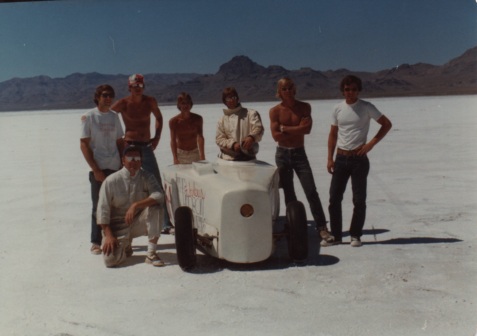
LESSONS LEARNED
- Racing is a good training ground for humility
- Not everyone can do this
- Race car must be towed
- Rock stars at Bonneville gave us advice, helped the youngest, most naïve players there and appreciated our eagerness and our stupidity. They called us the Hudson Boys and the name stuck.
- Cheap, easy racing isn’t
- Try to not make the same mistake twice (but every year we find new ways to do things wrong – once).
- One of the few sports that you can have so much fun into your 70’s and 80’s. Looking forward to our next ten years.
